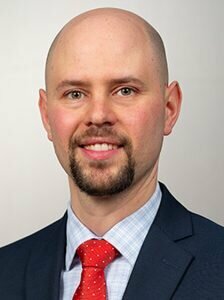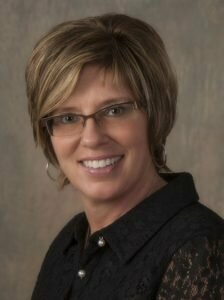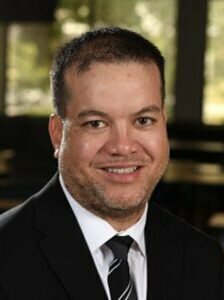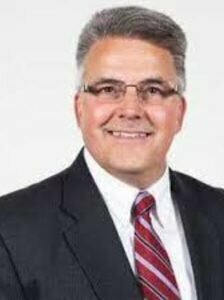The 2024 forecast for the Northwest Indiana economy is mostly an optimistic one, according to the experts that presented during the recent Business & Economic Outlook. During the event, a cross section of industry leaders delivered their expectations for the coming year. The Northwest Indiana Business RoundTable (NWIBRT) and the Construction Advancement Foundation (CAF) host the economic outlook each autumn to provide the regional business community with insights about topics that may impact companies and communities.
State of the NWI Economy
 “Economics is known as the ‘dismal science,’ but it’s not dismal today! This might be the strongest time the NWI economy has been in over a decade,” said Dr. Micah Pollak, associate professor of economics with Indiana University Northwest (IUN), during his comprehensive overview about expectations for the regional economy throughout 2024.
“Economics is known as the ‘dismal science,’ but it’s not dismal today! This might be the strongest time the NWI economy has been in over a decade,” said Dr. Micah Pollak, associate professor of economics with Indiana University Northwest (IUN), during his comprehensive overview about expectations for the regional economy throughout 2024.
“Of course, that’s not really how many people perceive our economy. But I hope to close some of that gap today,” Dr. Pollak said. “The reality check here is the positive trend in U.S. Real GDP, showing an average growth of 2.6% per year. When accounting for the pandemic, our recovery has us back on track to where we were – even slightly above where we’d expect to be. We’re doing as well, or if not better, than if there hadn’t been a pandemic.”
During a rapid-fire rundown of several positive factors, Dr. Pollak said that gas prices are coming down, it seems like the federal reserve has “stuck the landing” in its efforts to stabilize inflation, the long-run averages of interest rates are fairly normal (although they feel high, historically speaking they’re not), and we have strong economic growth. All of which is great for NWI, Dr. Pollak said.
“The pandemic raised income dramatically. We’ve never seen such a large increase in salaries and wages. We’re seeing fewer people working multiple jobs, and poverty rate reductions especially among young children,” Dr. Pollak said.
Economic conditions are also strong for NWI firms. From 2020 to 2022, the region added about 1,400 new businesses. Compared to Cook County, IL, which is much bigger than us, they only added 805 businesses. They are 8 times our size, but we added 1.7 times more businesses.
Union construction man-hours has returned to their pre-covid levels too indicating a healthy resurgence in all kinds of regional projects.
“The best question to assess economic prosperity is ‘Do people generally want to move here?’ The answer used to be NO. But that’s no longer the case. It’s a big YES,” Dr. Pollak said. “People are looking at Northwest Indiana much more seriously. Lots of companies are seeing to move here when they overlooked us in the past. The quality of place investments that have been happening here have been massive, and I think we’re really seeing the rewards manifesting now. We’ll see more as we continue.”
As for NWI’s challenges, Dr. Pollak said that we still have a “brain drain” problem. Young, educated people have a trend of moving away from the region. We are doing much better at retaining these individuals than we have in previous decades, but it’s still an issue. Also, our unemployment rates remain at historic lows, which means it’s going to continue to be a very tight labor market moving forward.
Dr. Pollak’s conservative prediction for 2024 included moderate growth in Real GDP (+1-2%), slight employment growth (+0.5%), slight labor force growth (+0.25%), no major changes to unemployment (between 4.5% and 5.5%), and strong growth in wages/salaries, (+2-3%), and strong growth in personal income (+3-4%).
Talent Competition
 Workforce challenges are on the minds of just about every employer these days. That’s why so many entities have been collaborating to boost the talent pipeline. Lisa Daugherty, president and CEO of the Center of Workforce Innovations (CWI), a nonprofit organization that provides workforce development initiatives throughout the seven NWI counties, spoke about many of the collaborative efforts that have been happening in our region. These would include talent development activities in the healthcare sector, building and trades, agriculture, employee upskilling, and many others.
Workforce challenges are on the minds of just about every employer these days. That’s why so many entities have been collaborating to boost the talent pipeline. Lisa Daugherty, president and CEO of the Center of Workforce Innovations (CWI), a nonprofit organization that provides workforce development initiatives throughout the seven NWI counties, spoke about many of the collaborative efforts that have been happening in our region. These would include talent development activities in the healthcare sector, building and trades, agriculture, employee upskilling, and many others.
“Northwest Indiana has returned to full employment after the dip in 2020. Job posting data shows just how competitive the job market is right now. It’s at times painful for employers, as many are competing for the same talent,” Daugherty said.
More and more high school graduates are not entering college nor entering into the workforce, and high school outreach programs may not be a cure-all for an employer’s hiring goals. Daugherty commented there is no “big demographic savior” on the horizon, as the overall working age population is only expected to decline.
But there are populations that employers generally haven’t tapped into – which she described as “non-traditional applicants.” These would include those without a high school diploma, formerly incarcerated individuals, and others.
“These individuals are eager to work, they just need an opportunity,” Daugherty said.
The CWI has also been active in expanding talent pipelines on numerous fronts, such as career pathway mapping, building engagement with employers, technical education planning, and work-based learning programs. Daugherty invited and encouraged more employers to get involved with these types of programs, to provide their input so educators can better understand labor force needs.
“The unions have a phenomenal work-based learning model through their apprenticeships. Apprentices earn while they learn, and we can apply that model to almost any other industry,” Daugherty said. “It’s also a powerful retention tool.”
Real Estate and New Neighbors
 Sales of home sales in Northwest Indiana have dropped significantly in the last few years, even though there is still demand. Since 2021, total home sales have dropped by about a third, according to Peter Novak, CEO of the Northwest Indiana REALTORS Association (NIRA), a professional trade association that represents about 4,000 realtor members.
Sales of home sales in Northwest Indiana have dropped significantly in the last few years, even though there is still demand. Since 2021, total home sales have dropped by about a third, according to Peter Novak, CEO of the Northwest Indiana REALTORS Association (NIRA), a professional trade association that represents about 4,000 realtor members.
“These declines in home sales can be tied directly to the rise in interest rates – which was the point, of course. But even though demand has waned, it has not declined to the point where we have a balanced market. The lack of available inventory is the core issue,” Novak said. “It’s still substantially a seller’s market.”
Year to date, the region is down about 12% in new listings, which Novak said is nothing new. But the rise in interest rates has created a two-sided impact – it’s been cooling demand but also turning off many sellers, thus reducing inventory further.
But one of the plus sides about living in the NWI region is the fact that home prices in general are much lower than Chicago metro averages and national averages. Median selling prices are about $242K here, $325K in the Chicago metro area, and $394K nationally – even though inventory in the region is lower than those other areas.
“From a supply and demand standpoint, and a value standpoint, Northwest Indiana is much better than these other areas,” Novak said.
With regard to net migration, Novak shared an interesting set of heat maps that showed where people are moving two and from. Lake County has been drawing many of its new residents from Chicago-area counties, but also losing residents to Porter County.
Similarly, Porter County is drawing most of its new residents from Lake County, but also losing residents to La Porte and Jasper Counties.
Novak’s outlook for 2024 described a continued decline in home sales through the year. Prices are expected to decline as supply closes the gap with demand, and interest rates are expected to decline in 2024.
Growing Agribusiness
 Did you know that farm output in Indiana contributes roughly $35 billion to our economy? Agriculture is the second-largest industry in our state, following manufacturing. All of this makes Indiana the 8th-largest state in the country for farming, and lately lots of new opportunities have been headed our way, according to Bruce Kettler, president and CEO of the Agribusiness Council of Indiana (ACI).
Did you know that farm output in Indiana contributes roughly $35 billion to our economy? Agriculture is the second-largest industry in our state, following manufacturing. All of this makes Indiana the 8th-largest state in the country for farming, and lately lots of new opportunities have been headed our way, according to Bruce Kettler, president and CEO of the Agribusiness Council of Indiana (ACI).
“Throughout the world, middle-class populations are projected to grow significantly by 2030. Why do we focus on the middle class? As these populations grow, these populations consume more. They also eat more meat. And our farmers are the ones who will produce these goods,” Kettler said.
He continued by explaining that Indiana has abundant natural resources, and the industry has a commitment to boost sustainability to preserve these assets. Hoosier agribusiness is also extremely productive, innovative, and diverse in terms of the products we raise and ship throughout the world. Companies have also been pioneering new types of agriculture, like vertical farming and controlled environment (indoor) production.
“There’s a new facility here in Indiana where crops are grown, raised, watered, cut, packaged, and shipped without a single human hand making actual contact with the crop. It’s all automated, and it’s amazing,” Kettler said. “We also have robotic dairy operations now, where robots milk cows. There’s so much room for innovation in this sector.”
Some of the challenges facing the sector include labor issues, supply chain constraints, regulation, and higher interest rates – which one would expect. But the loss of available farmland is also becoming a big deal for Indiana agribusiness. Kettler said that folks in his industry are not opposed to economic development, but they have been working with legislators to determine the best uses for available land.
Walking the Trails
 In 1990, NWI had about 13 miles of trails in the area. Today we have nearly 200. Mitch Barloga, transportation planning manager with the Northwestern Indiana Regional Planning Commission (NIRPC), spoke about the rise in popularity of these amenities and the increased levels of investment that has brought new pathways to life – all of which has a significant impact on quality of place for our communities.
In 1990, NWI had about 13 miles of trails in the area. Today we have nearly 200. Mitch Barloga, transportation planning manager with the Northwestern Indiana Regional Planning Commission (NIRPC), spoke about the rise in popularity of these amenities and the increased levels of investment that has brought new pathways to life – all of which has a significant impact on quality of place for our communities.
“Trails, why do they matter? And why should you care?” Barloga asked. “Well, you also have to ask, what brings people to communities? We’ve found that the second-most sought-after amenity is trailways. Trails bring together people, planet, and profit – three core pillars of economic development. They also promote tourism and business retention.”
One of the priority trails that NIRPC is focused on is called the Marquette Greenway, a 60-mile trail running from Chicago to New Buffalo, MI. About 24 miles are completed, another 35 is fully funded, and an additional mile is planned. The estimated total cost of the project is about $124 million, which will be supported by federal funding. The National Park Service has been a major part of this project, as the trailway will wind through almost all of the region’s National Park network.
NIRPC has also been working to develop numerous other safe routs for pedestrians and cyclists so they can reach many of the region’s destinations that are currently only accessible by car. These include new pathways, bridges, and even waterways.
Reentering Communities
The Indiana Department of Correction (IDOC) is one of the state’s largest agencies, with roughly a $1 billion annual budget. It’s much more than just prisons, with numerous activities focused on reentry, job training, skills attainment, and youth services. Annie Goeller, deputy commissioner of strategic alignment with the IDOC, described some of the recent developments taking shape within the IDOC, and the ways these can impact the region.
“The vast majority of our population is going to reenter society at some point. Most have sentences of 10 years or less, and we want these individuals to come back with the skills and education they’ll need to have a successful outcome,” Goeller said.
The IDOC has three different facilities in NWI, with a new $1.2 billion correctional facility on the way in Westville. The new campus will have 18,000 square feet of classroom space and over 200 beds for mental health and addiction recovery services. This will replace the Indiana State Prison and the current Westville Correctional Facility, which are both out of date (the Indiana State Prison was originally built when Abraham Lincoln was in office, for instance).
The timeline for construction for the new Westville campus will be three to four years. In the meantime, the IDOC is focused on staffing recruitment and retention, and retraining in the wake of new technology developments. Mental and behavioral health services are also a major priority for the IDOC because they can help reduce recidivism rates.
“So much of what we do is focused on reentry. We’re developing programs to help incarcerated people find purpose, find meaning, so they can return to society,” Goeller said. “We’ve also been educating companies about people that have turned their life around through gainful employment.”
Talking Trains
 Some of the biggest transportation investments in the state of Indiana these last few years have been the rail infrastructure projects in the region. Sherri Ziller, president and CEO of the NWI Regional Development Authority (RDA), provided several updates on these massive projects.
Some of the biggest transportation investments in the state of Indiana these last few years have been the rail infrastructure projects in the region. Sherri Ziller, president and CEO of the NWI Regional Development Authority (RDA), provided several updates on these massive projects.
The West Lake Corridor railway project is roughly a third of the way complete, and the South Shore Double Tracking project is roughly 66% complete and due to finish next year. Most of the Transit Development Districts surrounding these projects and their commuter stations have been approved, with only a few left remaining.
Developers are already active on major investment projects surrounding these railways – totaling around $500 million worth of projects. For example, there’s Munster’s $163 million Lansing Country Club Medical Campus, Michigan City’s $80 million 11th Street mixed use development, and numerous others. Ziller commented that it’s very possible we’ll be seeing investments exceeding current projections in the future.
The last item that Ziller discussed was the possibility of developing a Lake County Convention Center.
“Our role in that was to perform a feasibility study for a new convention center in Lake County. The updated study will be complete in 2024, and that will be presented to county commissioners who will determine whether or not we opt to build a new convention center,” Ziller said.